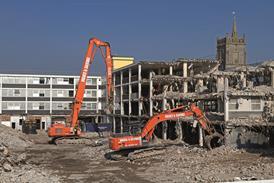Services contracts are particularly susceptible to change, because of the length of time over which they run and the way in which the buying organisation’s needs constantly change. So the success of any services contract depends on it being established on a sound foundation. The design of that foundation is the invitation to tender (ITT). Its fundamental elements are:
- clear instructions to ensure tenders are submitted in the required format and in compliance with the buyer’s requirements
- clearly identified terms and conditions that will apply to contracts stemming from the process
- an effective specification of the service required, supported by an information pack that covers the accommodation, plant, etc that are the subject of the service
- a clear and unambiguous form of tender and pricing schedules
A well-structured ITT facilitates an orderly preparation and submission of tender, and creates a sound, professional image of the client. There is no single way of constructing an ITT document, but a suggested format is:
- Covering letter inviting tenders
- Instructions to tenderers
- Form of tender, declaration and confidentiality agreement
- Contract conditions and agreement
- Schedule 1 – specification of services
- Schedule 2 – performance indicators and service levels
- Schedule 3 – resident site staff structure
- Schedule 4 – schedule of rates
- Schedule 5 – contract charge
- Schedule 6 – schedule of contract payments
- Schedule 7 – health and safety rules for contractors and sub-contractors
My previous articles (TheFB, May 2000, and TheFB, June 2000) dealt with specification writing. This month, I will concentrate on the content of the ‘instructions to tenderers’. Under each heading in the following model (which is not exhaustive) I suggest wording, which will be followed where necessary by an explanatory note.
Model instructions to tenderers
1 General information and definitions
1.1 In all matters relating to the tender the following documents shall apply and copies
are included in the ‘Contract terms and conditions’ enclosed with the invitation to tender documents.
ABC Company Ltd General conditions of contract for the supply of goods/services/equipment/construction (reference [insert reference and date])
ABC Company Ltd Purchase order conditions (reference [insert reference and date])
The success of any services contract depends on it being established on a sound foundation.
1.2 Throughout these documents all reference to ‘the Buyer’ shall mean the ABC Company Ltd and ‘the Seller’, ‘the Contractor’, or ‘the Supplier’ shall mean the party with whom the Buyer contracts for the provision of the facilities management services, which will be referred to throughout as ‘the Services’.
1.3 ABC Company Ltd will consider only tenders that are submitted fully in compliance with these instructions and which comprise all documents for ‘completion by Tenderer’ which are fully completed without amendment. ABC Company Ltd reserves the right to reject as invalid any tender which is not thus properly completed or which requires clarification, contains other conditions or non-required additions, deletions, mistakes, changes or calculating errors.
[Explanatory note Competition in ideas, methods and styles presents the problem of establishing a common basis for consideration of proposals that will satisfy procedures and subsequent related audits. A common practice is to specify a minimum acceptable level of service, against which all tenders are submitted, and then to invite alternative proposals (see also para 1.5). It is essential in doing this to emphasise that alternatives will be considered only if the base tender has first been submitted. This ensures that there is a common basis for comparison of tenders and provides tenderers with the opportunity to demonstrate their creativity. It also ensures that there is a firm tender base from which to evaluate the comparative benefit of the alternative offers. In this way, buyers can begin to provide a sound base for judgements on value for money issues.]
1.4 Tenders (two bound copies and one unbound to facilitate further photocopying) must be returned by [insert time] on [insert date] addressed to: [insert name and address].
[Explanatory note The danger of photocopying tender documents within the buyer organisation is that parts of a large document can go astray and tender evaluation could thus be compromised. It is preferable to require tenderers to submit the requisite number of copies for evaluation purposes. Some organisations adopt the approach shown in the model, ie, to request a minimum number of copies, one of them loosely bound to facilitate further copies being made. If that approach is adopted, it is vital that copying is carefully controlled and monitored to ensure accuracy and preserve confidentiality. Alternatively, require tenders to be submitted in hard copy and on disc for further dissemination. Given the bulk of paperwork that can be involved it might be worth considering issuing the ITT on disc to reduce the printing load.]
If ABC Company’s own blank and/or return envelopes are attached, please use these only. If no return envelopes are attached, tenderers shall submit their tenders in a closed and sealed envelope, which does not in any way identify the tenderer and which shall clearly be marked:
‘Confidential proposal – unopened to’
Any tender which is received later than the time stated above will not be admitted into consideration. *
ABC Company reserves the right not to admit into consideration any tender which is received later than the time stated above. *
* Select whichever is appropriate.
[Explanatory note The treatment of late tenders will depend largely on the precise nature of an organisation’s tender opening procedures. Some operate a strict ‘tender board’ approach with the board comprising disinterested parties and meeting behind locked doors with scrupulously observed security procedures to ensure impartiality and confidentiality. Others operate formal but less severe procedures. Whichever is the case, the problem will arise of late tenders and it is essential everyone involved is clear about the procedure that will be followed. The surest way of avoiding any suggestion of collusion between a buying organisation and a company submitting a late tender is to adopt the strict approach that any tender received after the due time will not be admitted into consideration. This can, however, operate unfairly against a tenderer and to the disadvantage of the buying organisation. It is reasonable to consider whether a tender is genuinely late (ie, was despatched in such a way or at such a time as to make it impossible for the tender to be received in time) or technically late (ie, its delivery/receipt was delayed by cause(s) out of the tenderer’s control).]
1.5 Provided that tenders are submitted in accordance with para 1.3 and 1.4 above, ABC Company Ltd will consider alternative tenders, which must be kept separate from the main tender documents, but delivered by the same time and date, and should indicate the benefits to ABC Company Ltd which the alternative tenders purport to deliver, technically, operationally and commercially. The submission of alternative proposals might increase a tenderer’s chances of winning the contract.
1.6 All tenders must remain open for acceptance for a period of [insert period] from the return date specified at para 1.4 above.
1.7 ABC Company Ltd is not obliged to accept the lowest or any tender submitted and may accept any part of any tender unless the tender expressly precludes part acceptance.
[Explanatory note Experience shows that in some instances none of the tenders is acceptable or no one tender presents the most advantageous solution for the client. The best value for money might well be to provide the service in-house or to divide the service provision between two or more contractors. A client should always reserve the right not to accept any tender or to divide work among contractors. This should always be expressly included in the documentation to avoid any possible implication of an ‘implied contract’ to accept a tender.]
2 Tenderers to inform themselves fully
2.1 Notwithstanding the information provided by the Buyer to facilitate the preparation of tenders, it is the responsibility of each tenderer to visit the sites where the Services are to be provided, to check the accuracy of all information provided by the Buyer and to satisfy itself that it has all the necessary information to submit a bona fide tender. The Buyer will not entertain any claim from any tenderer or from the Supplier which arises from any failure to exercise that responsibility.
2.2 Tenderers may not visit the sites, however, without the agreement of and co-ordination of visits by the following ABC Company’s representative(s): [insert names, addresses and telephone/fax/e-mail as appropriate]
To facilitate the process of site inspection, the Buyer’s representative(s) shall be available on [insert date] from [insert time] to [insert time] to conduct a tour of the facilities. Tenderers must notify in advance their intention to attend on this day together with the names of their representatives.
3 Queries during the tender period
3.1 All tenderers shall undertake to clarify any queries arising out of this tender before submission of their tenders. To assist in this process, all tenderers are invited to attend [insert site details] on [insert date] at [insert time] at which time all queries may be tabled and clarification given by the Buyer’s representative.
Note that representation at this meeting may not exceed [insert number] per Tenderer. Please notify the names of representatives in advance to [insert names, addresses and telephone/fax/e-mail as appropriate – as in para
2.2 above].
[Explanatory note It is common practice to tell tenderers that they are wholly responsible for ensuring that they have all the information they need on which to construct a bona fide tender. It is preferable, however, to provide a set day and time for site visits at which all tenderers should be represented. This gives the client the opportunity to see clearly who has attended the site and to make judgements on the amount of interest shown by tenderers. Such visits can be combined with a general meeting of all concerned to answer queries that have arisen from the visit and/or the tender documentation. On large and complex sites it might be necessary to handle the visit and the meeting on different days. Control the numbers of representatives to keep the whole thing manageable.
Source
The Facilities Business
Postscript
David Pearson is managing partner of DJP Consultancy.



















